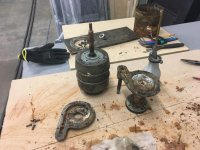Hello Everyone,
I am a new member of the forum, and a new owner of a Hardinge HLV.
The plate where I think the serial would be is too worn to read, so I can't work out a date, but I think 1963, if the previous seller was right.
I bought this from the civil engineering department of Imperial College London.
My current issues are:
1. The Carriage Feed Motor
2. The coolant pump
With regards to the carriage feed motor -
It worked the first time I tried it, and then the second time it smoked - I'm not sure if it moved and then smoked, or whether it just smoked - the motor not the control box.
I've taken it apart and it looks fine - a bit gunky but nothing out of the ordinary.
I'm waiting for a replacement multimeter to turn up in the post as mine is shot, so this is on hold for the next few days.
The coolant pump -
They obviously ran this with water based coolant - and then left it with it in the tank to rust.
I am disassembling the pump at the moment - I think I could get away with a rebuild if I can find a replacement impeller.
Or make one, if I can see one that isn't completely corroded away.
Are there any diagrams of the coolant pump assembly?
Also are there replacement filtration screens for surrounding the pump?
More generally, are there any basic lubrication tasks I should do to bring the lathe back into comission? (other than cleaning and refilling the apron oil reservoir on the top of the saddle).
Any help would be appreciated!
All the best,
Reuben


I am a new member of the forum, and a new owner of a Hardinge HLV.
The plate where I think the serial would be is too worn to read, so I can't work out a date, but I think 1963, if the previous seller was right.
I bought this from the civil engineering department of Imperial College London.
My current issues are:
1. The Carriage Feed Motor
2. The coolant pump
With regards to the carriage feed motor -
It worked the first time I tried it, and then the second time it smoked - I'm not sure if it moved and then smoked, or whether it just smoked - the motor not the control box.
I've taken it apart and it looks fine - a bit gunky but nothing out of the ordinary.
I'm waiting for a replacement multimeter to turn up in the post as mine is shot, so this is on hold for the next few days.
The coolant pump -
They obviously ran this with water based coolant - and then left it with it in the tank to rust.
I am disassembling the pump at the moment - I think I could get away with a rebuild if I can find a replacement impeller.
Or make one, if I can see one that isn't completely corroded away.
Are there any diagrams of the coolant pump assembly?
Also are there replacement filtration screens for surrounding the pump?
More generally, are there any basic lubrication tasks I should do to bring the lathe back into comission? (other than cleaning and refilling the apron oil reservoir on the top of the saddle).
Any help would be appreciated!
All the best,
Reuben











